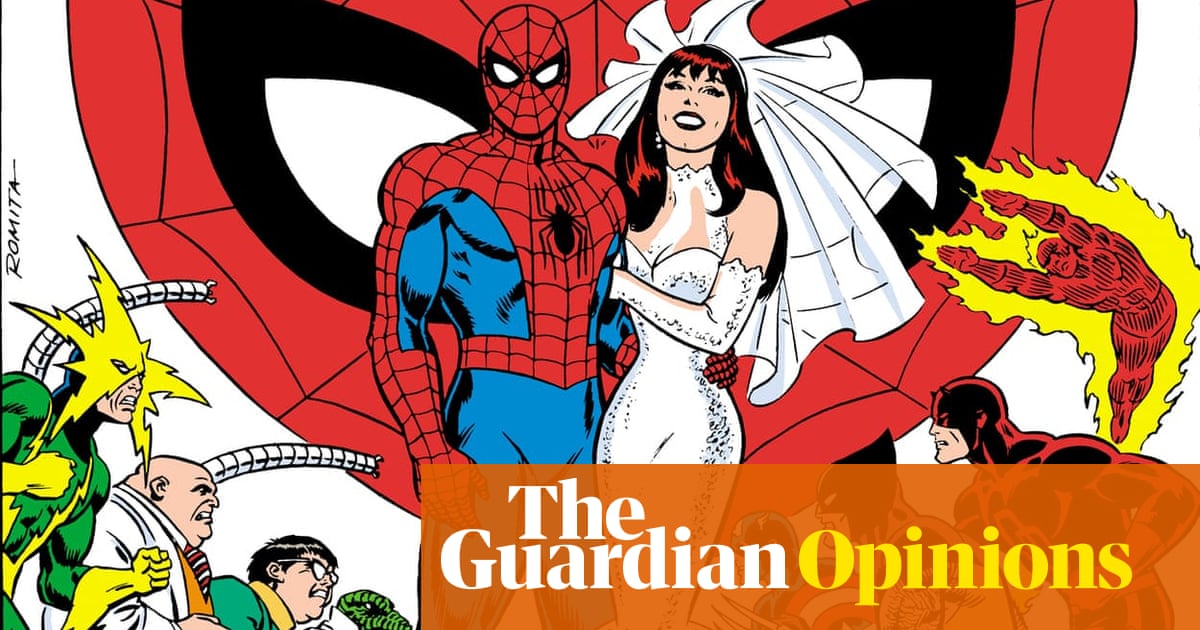
Not a spider – and not a man – but the most powerful teenage kid in pop-culture history. Spider-Man is the lonely, sensitive, adolescent underdog whose high-school miseries and humiliations, combined with his secret superheroic triumphs, have been comic-book crack for generations of fascinated fans and a gateway drug to the Marvel world itself.
He first appeared in Marvel Comics almost 60 years ago: the orphaned young science prodigy, Peter Parker, bitten by a radioactive spider at an educational exhibit. (Like Godzilla, Spider-Man is a product of the nuclear age.) He acquires the proportionate strength of a spider, a tingly “spider sense” for danger, and the ability to climb up walls. He designs his own body-hugging web-motif costume and web-shooting wrist modules and becomes a superhero, battling people such as the Green Goblin and Doctor Octopus. But he is somehow unable to reveal his secret to his high-school crush Mary Jane Watson and, as humble Parker, gets bullied by the high-school jock Flash Thompson who – ironically – fan-worships Spider-Man. So Spider-Man’s victories coexist with despair and depression: he fails to save his Uncle Ben, killed by a street criminal, and his entire superhero career is driven by that primal scene of failure and guilt – a Rosebud of wretchedness.
Spider-Man is the arachnid Harry Potter (or is it truer to say that Potter is the humanoid Spidey?) and the new film, Spider-Man: No Way Home is now crushing the box office and crashing booking websites all over the UK. In these times of woe, it seems we want the established favourite: Spider-Man, in his wacky outfit, defying the laws of physics to swing through the big city on his super-strong web. Sometimes he’s a high-schooler, sometimes he’s a college student, or older, but always resets and reboots to his true teenage self.
Spider-Man was invented by Stan Lee in 1962 to speak to Marvel’s surging new teen readership and first introduced to British fans with the UK’s Spider-Man Comics Weekly in 1973, spun off from The Mighty World of Marvel. For 40 years, Spider-Man was a potent brand favourite, with TV and video game spin-offs. But in the new century, movies took the Spider-Man legend to the next level: a trio of films from director Sam Raimi with the sleepy-eyed Tobey Maguire in the lead role, culminating in a much-loathed threequel, Spider-Man 3, in which the 32-year-old Maguire was obviously too old. Then there were the two reboot movies, starring the smart, gawky, more emotionally available Andrew Garfield – but Garfield was to become disenchanted with the grind of representing a corporate icon. And then another Brit, the fresh-faced Tom Holland, became a hit as Spider-Man as the hero joined the Marvel Cinematic Universe. An animation, Spider-Man: Into the Spider-Verse, was headspinningly witty and surreal.
Why are billions of people so addicted to Spider-Man? Partly, it’s his superb and superbly illogical solution to the superheroic issue of flight. Superman can fly; Batman can’t (to use two examples from the rival DC comics franchise) but Spider-Man has somehow split the difference. By shooting his streams of super-strong web which splat hyper-adhesively against buildings, Spidey can swing like Tarzan high above the sidewalks. But wait. In reality, this would need a horizontal surface overhead (or conceivably a flag pole); just attaching the web to a vertical surface like a wall means that Spidey would hit the ground or the wall before the downswing was complete. It doesn’t make sense, which is why Spider-Man can only exist on the page or the screen. When a spectacular Broadway stage musical called Spider-Man: Turn Off The Dark was unveiled in 2010, with dire musical numbers from U2’s Bono and the Edge, it was an unspeakable disaster – at least partly because the “flying/swinging” scenes were so terrible. At one moment, Spider-Man flew off over the audiences towards the balcony and a wire malfunction meant that he just stopped (like the notorious picture of Boris Johnson with his union jacks) and dangled mortifyingly. The real world exposes the absurdity of Spider-Man’s web-borne defying of gravity.
Then there’s that web-shooting technology itself. Is it all in the, erm, wrist action? It has exerted a terrible, inexplicable fascination for young male Spidey fans for 60 years. Poor lonely Peter Parker, deeply unlucky in love, obsessed with a certain young woman, but now endowed with the ability to shoot jets of sticky stuff using a controlled, convulsive movement of his wrist. Once you see the psychological subtext of Spider-Man’s webslinger heroics, it cannot be unseen. And in fact, part of the fascination of Spider-Man’s superpowers is that they somehow feel like histrionic enlargements or dramatisations of his existing weaknesses.
And then of course there is also the question of identity, that issue which has a new relevance. Shy, cerebral Peter Parker is bullied by someone at school who idolises Spider-Man. And also Peter Parker makes a few bucks selling photos of Spider-Man in action to the irascible newspaper editor J Jonah Jameson (who in the later movies is to evolve into a gruesome Alex Jones shock-jock figure) and this media monster hates Spider-Man; is Spider-Man-phobic in fact. Some of the movies are about the issue of whether Spider-Man should “come out” as a superhero or keep his double-life a secret. This too has resonated with armies of young people all over the world. Spider-Man continues to have audiences enfolded in his sticky web.












